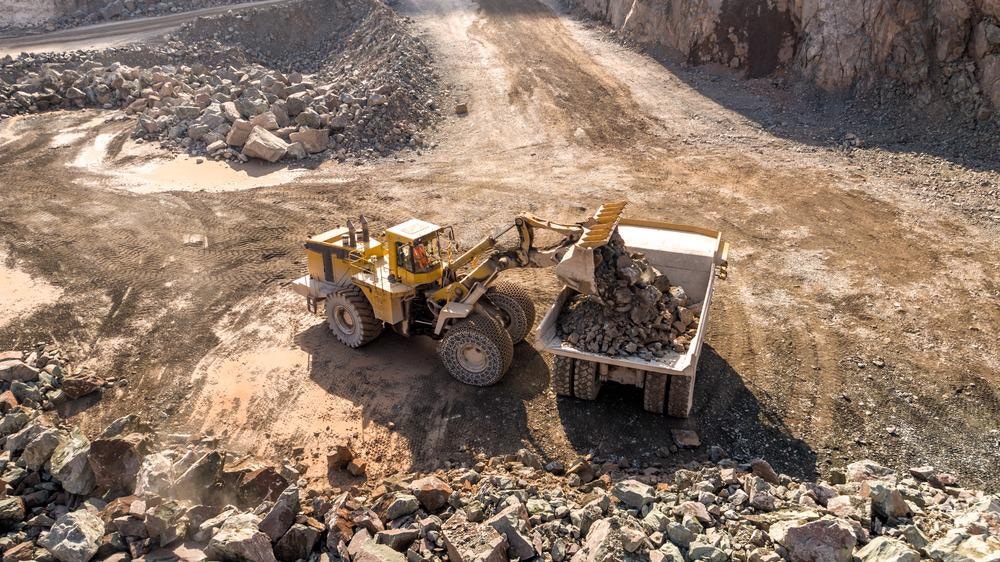The mining industry is facing several challenges in the 21st century, including the ecological damage created by industrial activities and developing strategies to address the issue of declining ore grades. This article will discuss the history of ore mining, the role of research, and developments such as improved iron ore mining equipment.

Image Credit: CloudVisual/Shutterstock.com
The History of Ore Mining
Mining for ore is a critical economic activity with a long history. In prehistoric times, humans initially gathered resources on the surface and fashioned stone tools, with the discovery of processing methods for metals such as copper, tin, and iron driving ancient industrial revolutions. Over time, humans started to exploit resources in open pits and underground mines.
Neolithic flint mines at locations such as Mons in Belgium are early examples of the transition from open pit to underground shaft mining. A major shift in resource exploitation away from utilitarian needs came with the discovery that certain minerals could be used in paint for decorative purposes, with cave paintings found across the world testament to this revolution in mineral exploitation. Over the course of the next few millennia, humans discovered that mineral ores could be processed into useful objects such as agricultural equipment and weapons.
Today, with advances in technology since the Industrial Revolution providing the means to exploit deeper resources and improve safety and the economic viability of mines, humans continue to extract critical resources which are essential for modern industrialized society.
The Current Challenges with Ore Mining
Mining for ore is an activity wrought with challenges. Sustainability and the decline in ore grades and exploitable deposits are key issues that modern mining companies face going forward into the 21st century.
A “bigger is better” approach to iron ore mining equipment, for example, and mining infrastructure may increase throughput, but comes at the cost of energy and water consumption, greenhouse gas emissions, waste, and higher capital intensity to meet investment hurdles.
The decline in ore grades and deposits presents several challenges for the mining sector. Unit production costs increase because more material needs to be processed containing reduced amounts of commercially viable minerals and metals. Consequently, capital costs increase, impacting the profit margins and economic viability of mining operations. Moreover, energy and water demands increase, further impacting the sustainability of exploiting critical minerals and metals.
How Research is Tackling This Challenge
Research and innovation in ore mining have driven solutions to this challenge. The issue is not just one of depleted resources: the challenge is a complex one that is governed by several factors besides this. These include improvements in ore mining equipment, innovations, and extending the useable life of existing mines instead of exploiting untapped resources. In some cases, as ore grades decline, deposit size increases.
Robust analysis is needed to tackle this issue and provide a better understanding of the relationship between changing ore grades and energy intensity.
Understanding the factors influencing declining grades provides mining planners and engineers with the ability to plan mines more effectively, improving the efficiency, productivity, sustainability, and economic viability of both new and old mines.
NextOre – A Recent Innovation
Several innovations have been driving the mining industry, such as improving connectivity in mines and the smart mining concept, which utilizes data and innovative technologies to create the mine of the future.
Next-level innovation can help to overcome challenges in modern mining, reducing the environmental impact of mines, lowering their operational costs, and achieving higher mineral and metal recovery.
NextOre is one such example of an innovative approach to tackling this issue.
NextOre is a joint venture between Worley, CSIRO, and RCF Ambrian.
The basis of the award-winning NextOre technology is magnetic resonance technology. The approach improves ore sorting capabilities with high-throughput abilities.
Traditional ore sorting can only be applied at low production rates, and systems are impractical in brownfield sites.
Coarser ores can be evaluated and sorted using NextOre’s magnetic resonance technology, improving accuracy and speed.
Conventional technologies can only analyze mineral particles at the surface of ores or near their surface.
The technology provides benefits for sustainability, cost, energy consumption, and production efficiency. High-volume, low-grade ore can be processed earlier in the development phase, with increased feed grade providing significant benefits for mine companies.
NextOre has collaborated with companies to boost mineral and metal production. Working with Capstone Milling in 2019, the venture’s approach increased the recovery of copper metal by 8% without any changes in mined material.
Collaborative work with a mining company in the Philippines improved metal production from low-grade ore, achieving a feed capacity of 1000 tons per hour.
The Future of Ore Mining
The history of ore mining is one of innovation and evolution.
Mining for ore in the 21st century is challenging, with ore grade decline pushing further innovation in the mining ecosystem.
Sustainability, economic viability, and productivity are key concerns in the mining industry, and through innovative approaches such as NextOre’s magnetic resonance ore sorting and analysis technology, the mining industry will be able to ensure its future viability.
References and Further Reading
Worley (2021) How next-level innovation is helping depleting ore grades [online] mining-technology.com. Available at: https://www.mining-technology.com/sponsored/next-level-innovation-helping-depleting-ore-grades/
Calvo, G et al. (2016) Decreasing Ore Grades in Global Metallic Mining: A Theoretical Issue or a Global Reality? Resources 5(4) mdpi.com. Available at: https://www.mdpi.com/2079-9276/5/4/36/htm
National Geographic (2022) Mining [online] nationalgeographic.com. Available at: https://www.nationalgeographic.org/encyclopedia/mining
Ame (2018) Copper- Declining copper ore grades [online] aus.amegroup.com. Available at: https://aus.amegroup.com/Website/FeatureArticleDetail.aspx?faId=437
Disclaimer: The views expressed here are those of the author expressed in their private capacity and do not necessarily represent the views of AZoM.com Limited T/A AZoNetwork the owner and operator of this website. This disclaimer forms part of the Terms and conditions of use of this website.